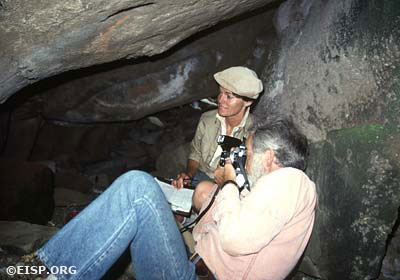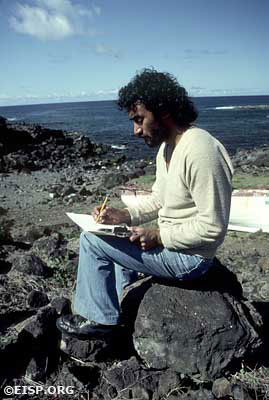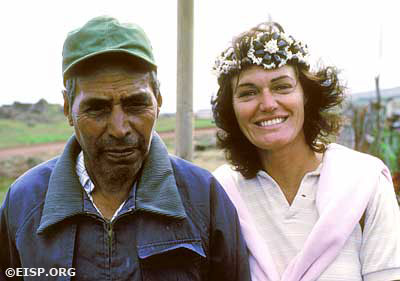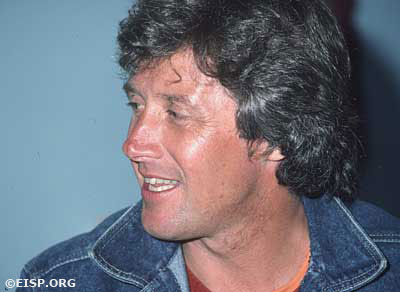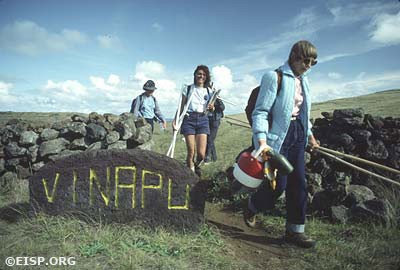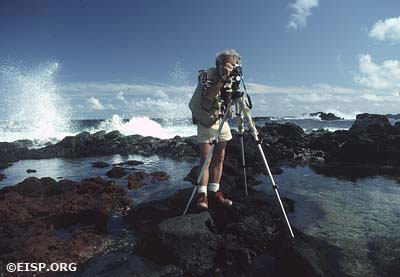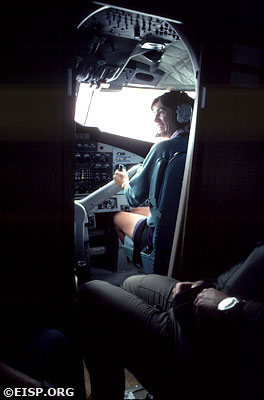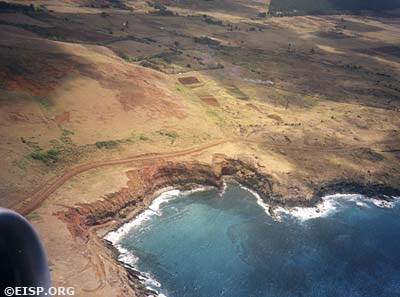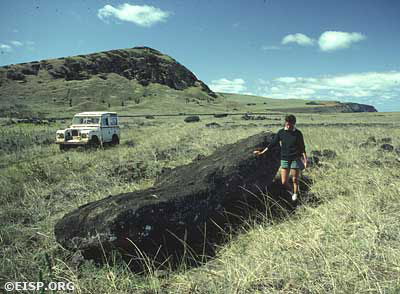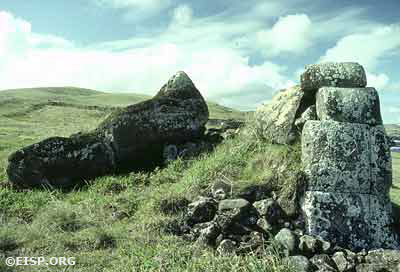Easter Island Statue Project History: 1983
“It was a lengthy work, for not only are the figures and ruins very numerous, but it was found that not till after some six months’ study could they even be seen with intelligent eyes.”
Katherine Routledge (1919:xi).
Goals and Methods
The overall, initial goal of the Easter Island Statue Project is the systematic documentation of the island’s major archaeological artifact: the giant moai. Consistently applied criteria describe, in a thorough and orderly manner, the attributes of each statue. It is intended that all descriptive data collected will be analyzed to formulate a stylistic typology that will be a significant aid in chronological and other studies.
As an outcome of 1982 fieldwork, we had made changes to the basic statue attribute list, and to various categories of statue location and position. We also added categories of statue conservation data. Data collection forms were further revised for consistency and ease of use, with special attention given to the fact that the 1983 field season would be conducted with the help of University of California Research Expedition (UREP) volunteers. Architect Johannes (Jan) Van Tilburg assisted in Sessions I and IV.
The UREP plan called for four sessions of four volunteer members each. We would share a rented house in Hanga Roa. A broad range of skills and professional expertise in a variety of areas allowed volunteers to contribute to the work in meaningful ways. Participants were encouraged to contribute their own observations and speculations throughout the course of the fieldwork, and this led to a greatly enriched and expanded project.
Perhaps most important, we had the capable assistance of Felipe Teao A. About half way through the field season Raúl Paoa Ika, an able Rapa Nui draftsman, joined us. Raúl assisted Jan in the field, and both spent long hours at a drafting table in a studio set up in our rented house. They produced valuable finished drawings and architectural plans that were a significant supplement to statue data. Marty Gonzalez and Valerie De Gier volunteered during one session each, and Marty went on to write her Masters thesis in anthropology about Rapa Nui.
In the Field
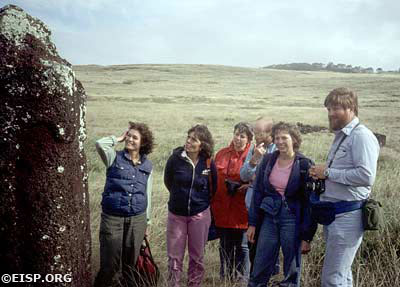
Jo Anne Van Tilburg (left) with Session I UREP volunteers at site 02-209-009. ©1983 EISP/JVT/Photo: D. C. Ochsner.
In quadrangles 12 and 13 the UREP Session I team located and measured fallen moai “in transport.” Along the coast, statues or fragments of statues were most often located on or in proximity to ahu. Others were located two to five kilometers inland over rocky terrain and through waist-high, rain-wet grass. The unpredictable nature of July weather on Rapa Nui caused more than a few anxious moments, but the Session I team was able to measure statues, sketch features, and document ahu at thirty-five sites. Important observations were made as to the positions of the statues relative to transport techniques and the re-use of statues as parts of structures. Petroglyphs on or near the statues were documented and scale drawings made.
Session II concentrated on the interior areas of quadrant 12, hiking five to ten kilometers daily over rough terrain in search of statues. This group also initiated a change in field methodology. Concentrating on the ancient road from Rano Raraku to the coast in quadrangle 13, we revised our data collection to include additional measurements required to make scale drawings. This served to convince us that our range of tolerance for accuracy, while narrow, could be improved. We began using bamboo rods to create straight lines and right angles to take more accurate measurements.
Jan Van Tilburg and Paul Diller designed a set of large scale, light weight calipers to use on the largest (sometimes broken) statues. Jan had them made in Los Angeles and then brought them later in the field season when he made his second trip to the island.
Session II systematically produced excellent field sketches and scale drawings. These were basic to the stylistic analysis of the moai, significantly expanding the research direction deeper into relevant questions of style in relation to transport technique. There was no copying machine available, and Jennifer Johnson and Frances Parker spent countless hours transferring by hand a mass of valuable duplicate data to the Centro files.
Session III began the related work of examining architectural style of ahu in relation to the statues. John Herbolsheimer, an experienced surveyor, did valuable work that allowed Jan to complete his architectural drawings. Working along the coast in blustery weather, we found some of the statues so badly damaged through wind and water erosion that it took long hours of detailed study before their various attributes could be discerned. This gave me, at last, the “intelligent eyes” that Katherine Routledge talked about in The Mystery of Easter Island.
A review of the 1982 data had indicated that more documentation was needed, particularly systematic photography. This task was taken on by David C. Ochsner, who shot black and white film along coastal sites, documenting all of the statues recorded in 1982 in quadrants 2, 5, and 6, as well as the coastal ahu of quadrants 12 and 13. Working with Lilian González N. of the Centro de Estudios team, he photographed approximately 90 statues in the interior and exterior of Rano Raraku. Prints of all of these were provided to the Centro.
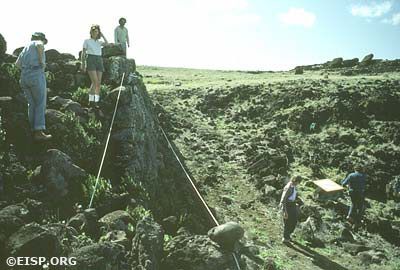
Jo Anne Van Tilburg (center, left) and Raúl Paoa Ika (center, rear) at site 07-581. ©1983 EISP/JVT/Photo: D. C. Ochsner.
Jan Van Tilburg returned to the island during Session IV, and he was a major asset to us as we began to draw detailed maps, elevations and plans of the major coastal ahu. His careful description of construction details during Session I, along with notes made by surveyor John Herbolsheimer during Session III, were compiled and amplified to produce highly accurate maps, elevations and plans for Ahu Vaihu (06-255); Ahu Akahanga (07-584) and two smaller, related sites (07-581 and 07-582); Ahu Ure Uranga Te Mahina (07-575); Ahu Hanga Te Tenga (12-003); Ahu Runga Va’e 12-212A and 12-447B; Ahu Oroi (12-460) and Ahu Hoa Anga Vaka Tua Poi (12-447). Particular attention was paid to the variation of construction methods visible in the seaward walls of the structures. The distinctly red color of the stone used in seaward walls was also noted, and during 1984 field work geologist Dr. Steve Williams aided Van Tilburg in further detailing it. Documentation of ahu site features, when coupled with published obsidian hydration rates or radiocarbon dates, would be required for chronological studies and the integration of moai style with ahu construction phase.
Findings
During the 1983 field season we accomplished the documentation (through drawings, photographs, measurements, field drawings, and finished drawings) of one to forty statues on each of seventy-one sites. We mapped six major ahu sites fully, including construction details. Expanded research concerns now included revised ahu construction periods, correlation of statue types and ahu construction, examination of style as it relates to transport techniques, and reuse of fallen statues. A related outcome of this research would also be new and better information about the state of preservation of the statues. The importance of these data cannot be overestimated, and some distressing observations on vandalism and deterioration were recorded. The giant calipers we designed had worked rather well, but not to our complete satisfaction. New ones were designed and made for the following year.
Want to know more?
Gonzalez, M.E. 1984. “The archaeoastronomy and ethnoastronomy of Easter Island.” MA thesis, California State University, Long Beach.
Routledge, K. 1919. The Mystery of Easter Island. London: Sifton, Praed & Co.
Van Tilburg, J. 1983. “Easter Island statuary: Preliminary report of fieldwork and projected hypotheses.” On file with the UCLA Rock Art Archive and the Centro de Estudios, University of Chile.
Van Tilburg, J. 1983. “The Easter Island statue carving tradition: An overview including its relationship to a similar tradition in the Marquesas.” Paper prepared for the participants on the UREP expedition, Easter Island statue project. On file with the UCLA Rock Art Archive and the Centro de Estudios, University of Chile.
 English
English  Español
Español 